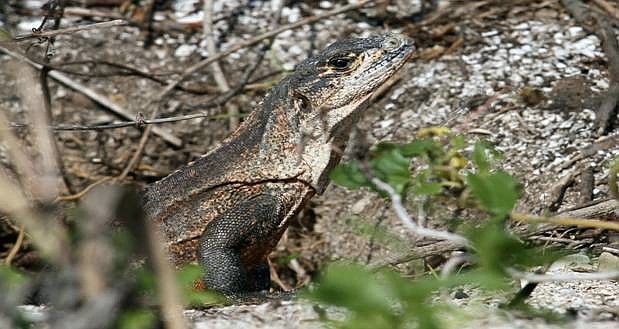- April 18, 2024
-
-
Loading

Loading

In some parts of the world, exotic reptiles are consumed on a regular basis, but Sarasota County Natural Resources staff is more interested in what the large lizards are swallowing.
The non-native reptiles, which mostly include iguanas, are omnivores, feeding mainly on light-colored flowers. But, they compete with Sarasota’s native species’ populations, and when vegetation starts running low, they are known to target gopher tortoise and sea-turtle eggs.
There have been reported sightings of a Tupinambis lizard, known in the exotic pet trade as a tegu, near Turtle Beach.
“It’s been hanging around there for a while, so it’s probably determined to be here,” said Sarasota County Environmental Specialist Chance Steed. “It’s probably only a matter of time before it’s captured there by a trapper.”
That’s good and bad news: if it stays in a central area, trappers and county staff have a better chance of trapping it, but there are still turtle nests in the area that could be targeted by the tegu.
Sarasota County staff isn’t allowed to do any trapping on private property, which is why county staff needs reports to figure out where lizards are roaming. But, the tegu is roaming on county property in Turtle Beach Park, which puts the county closer to capturing the rogue reptile, Steed said.
The presence of gopher tortoise holes is another aid to trapping efforts, albeit causing relative discomfort to the fellow reptiles.
“They don’t appear to be doing harm to the tortoises,” Steed said. “But, I’m sure the tortoises aren’t exactly thrilled to be sharing their homes.” When Steed suspects a lizard is holed up in a gopher tortoise burrow, he can place a trap near the entrance to snare it when the tortoise chases the lizard into the opening.
The tortoise experience illustrates collateral havoc iguanas and tegus can cause to native species.
“Although they may not be specifically targeted by reptiles, they’re still competing for food sources,” Steed said.
Trappers hired by Sarasota County use air rifles to control non-native lizard populations that have grown too large for traditional trapping means. A contractor cut down the amount of iguanas in Blind Pass Park on Manasota Key. It was just more efficient,” said Steed.
But, on Siesta Key, reptile wranglers use a hands-on trapping method — literally. “We go out and grab them by hand,” Steed said. “That’s probably one of the better ways to do it.
Once caught, exotic lizards are euthanized and put in a freezer. Steed said the county has considered implementing programs that would filter healthy found reptiles to pet stores, but their numbers are currently too high for that effort.
Instead, Sarasota County environmental specialists study their stomach contents to get a better idea of what areas they may be frequenting for food, and if they are doing environmental damage. The last such study, performed last year, showed positive findings. They didn’t find evidence of gopher tortoise or sea turtle eggs. It’s about time for another study, he said.
“When (residents) see something like this tegu, that looks suspicious and non-native, they need to report it,” Steed said.
“We don’t want it to be a situation like in Boca Grande where there was a lot of environmental destruction,” Steed said. The small island was overrun with more than 16,000 exotic reptiles in 2006, according to National Geographic News.
“We can’t be out there all the time,” he said. “It’s our diligent public that really helps keep numbers down.”
To report an iguana sighting call 861-5000.